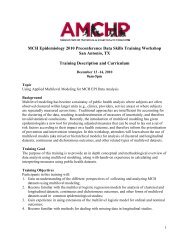Childhood Obesity: The Role of Health Policy - Association of ...
Childhood Obesity: The Role of Health Policy - Association of ...
Childhood Obesity: The Role of Health Policy - Association of ...
You also want an ePaper? Increase the reach of your titles
YUMPU automatically turns print PDFs into web optimized ePapers that Google loves.
the coverage available, including provider education on available coding practices (including which codes<br />
to use under which circumstance and in which settings) to support obesity-related services.<br />
• All health care payers (including public, private and self-insured employer plans) should be innovative<br />
in their coverage and reimbursement policies by providing incentives for providing obesity-related<br />
services (e.g., the % <strong>of</strong> children in the practice for whom a BMI is recorded in the medical record) or<br />
by making certain school- and community-based activities by physicians eligible for compensation or<br />
incentives (e.g., participation in school wellness councils).<br />
• <strong>The</strong> Federal Centers for Medicare and Medicaid Services (CMS), should make clear to states which<br />
obesity-related services and activities (including disease prevention and health promotion) are eligible for<br />
Federal Financial Participation (FFP) and at what level (e.g., 50% match or greater). This includes, but is<br />
not limited to, reimbursements for clinical services provided in the clinical-, school-, or community-based<br />
setting, and the development <strong>of</strong> a data infrastructure to address obesity (e.g., obesity registries).<br />
• Congress should appropriate funding for CMS, and if necessary clarify CMS authority, to fund<br />
demonstrations to determine the most effective approaches to addressing the epidemic.<br />
• Employers should evaluate their benefit plan <strong>of</strong>ferings and remove obstacles to the prevention and<br />
treatment <strong>of</strong> childhood overweight, e.g., by considering coverage <strong>of</strong> dietitian services and specialized<br />
treatment programs for children and teens.<br />
• Employers should select health plans and providers that follow screening and treatment guidelines to<br />
ensure identification and management <strong>of</strong> obese children and adolescents.<br />
• Employers should select health plans that help providers make childhood obesity prevention,<br />
identification and management a priority in all patient encounters.<br />
• Employers should select or reward health plans that develop effective healthy weight and weight<br />
reduction programs for children and families.<br />
Strategy 4: Leverage regulatory and accreditation approaches in promoting clinician<br />
engagement<br />
• <strong>The</strong> American Board <strong>of</strong> Pediatrics and the American Board <strong>of</strong> Family Practice should increase the<br />
number/scope <strong>of</strong> obesity-related content in their certification and maintenance <strong>of</strong> certification<br />
(MOC) exams.<br />
• Subspecialty boards in those disciplines seeing and treating obese children (e.g., cardiologists,<br />
endocrinologists, surgeons) should also expand their content on childhood obesity and its<br />
consequences in their certification and MOC exams. 14<br />
• State Medical and Nursing Licensing Boards should mandate that at least two hours <strong>of</strong> the states’<br />
CME/CEU licensing requirements be devoted to obesity, including childhood obesity, and how<br />
interventions vary between adult and child patients.<br />
• Accrediting bodies (such as the National Committee for Quality Assurance (NCQA), or the Joint<br />
Commission for Accreditation <strong>of</strong> <strong>Health</strong> Care Organizations (JCAHCO) should develop and require<br />
reporting on obesity-related measures from accredited providers or plans, as well as emphasize<br />
quality improvement initiatives focused on obesity, including childhood obesity.<br />
14 This approach is already used by a number <strong>of</strong> states for topics such as the prevention <strong>of</strong> medical errors, domestic violence and HIV/AIDS.<br />
21



